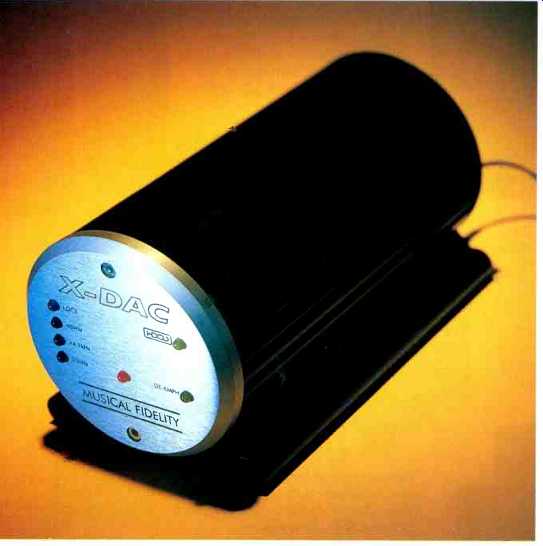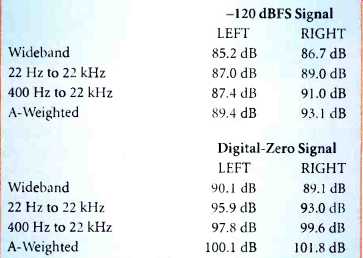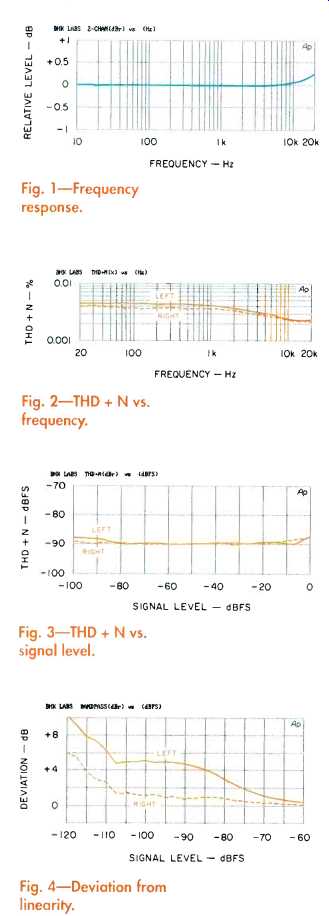

Dimensions: 4 3/8 in. W x 4 3/8 in. H x 8 3/4 in. D (11 cm x 11 cm x 22 cm).
Weight: 2.9 lbs. (1.3 kg).
Price: $595.
Company Address: c/o Audio Advisor, 4649 Danvers Dr. S.E., Kentwood, Mich. 49512, USA; 800/942-0220.
The X-DAC D/A converter is one of eight members of Musical Fidelity's X-Series family of audio products. The line also includes the X10-D Class-A tube line stage, the X-CANS Class-A tube headphone driver, the X-LP phono stage, the X-PRE Class-A tube preamp, the X-PSU power supply, the X TONE tone controller, and X-LINX interconnect cables. Each of these components, save the X-LINX cables, is housed in a 4 3/8 inch-diameter, 7 1/2-inch-long extruded aluminum cylinder, with inputs and outputs on one end plate and indicator lights (plus controls, if any) on the other.
The X-DAC's brushed-aluminum front panel is about 3/8 inch thick. Seven LEDs indicate operating modes: A green LED denotes signal lock, red LEDs are used for the three standard sampling frequencies (48, 44.1, and 32 kHz), yellow LEDs identify pre-emphasized and HDCD-encoded sources, and a red one indicates power on/off.
On the X-DAC's opposite end are two digital inputs (one coaxial and the other Toslink optical), two pairs of gold-plated RCA analog audio outputs, and a female connector that accepts 12-volt, 500-milliampere AC power from the separate "wall-wart" power supply.
Measurements The X-DAC's output voltage at digital full scale (0 dBFS) was 2.195 volts for the left channel and 2.206 volts for the right.
Surprisingly, these voltages did not drop at all when I switched from instrument to IHF loading. That's because the output impedance turned out to be considerably less than 1 ohm! Moreover, distortion at these full-scale output levels did not increase at any audio frequency when I switched from high-impedance to 100-ohm loads. Very impressive!
=========
Circuit Highlights
The X-DAC's digital input circuit feeds the output from the Toslink optical receiver to the S/P DIF coax connector's hot terminal through an isolating resistor. This is a simple and effective way to provide both input types without a switch, though it also means that only one of these inputs can be connected to a source at a time. A 74HC04 logic gate circuit squares up the selected input and moves the signal to the input of a Yamaha YM3623B digital receiver.
The recovered clock and data signals are passed into a Pacific Microsonics PMD100 digital filter and HDCD decoder. The eight-times-oversampled outputs from the PMD100 are connected to a Burr Brown PCM69AP, a dual 18-bit DAC chip. The latter's novel architecture, which combines a 10-bit and a 1-bit DAC, is said to achieve high resolution, minimal glitches, and low zero crossing distortion.
Two dual JRC 5532DD op-amps are used per channel to provide current-to-voltage (I/V) conversion, filtering, and output buffering. The incoming 12-volt AC from the external power supply is half-wave voltage-doubled to produce unregulated +25 and -25 volts DC. Two three-terminal regulators reduce this to +15 and-15 volts to operate the output op-amps. Additionally, the incoming AC is half wave rectified and filtered to produce about +13 volts DC. A supplementary RC-filter section follows, which feeds two three-terminal regulators that produce +5 volts to run the digital circuitry.
-B.H.K.
===========
Frequency response in the normal mode, i.e., without de-emphasis, is plotted in Fig. 1. With de-emphasis switched in, the response was virtually the same, suggesting that de-emphasis error was essentially zero.
Square-wave response was typical of linear-phase circuits, with symmetrical ringing about the vertical center line of each half cycle. Further, at full scale, the peaks of the ringing were not clipped off as they are by the commonly used NPC digital filters. The X-DAC did not invert signal polarity.
Total harmonic distortion plus noise (THD + N) at digital full scale is shown in a Fig. 2; Fig. 3 displays THD + N of a 1-kHz tone as a function of digital signal level. The X-DAC's overall noise and distortion performance is good but not state of the art. But then, the X-DAC doesn't have a state-of-the-art price, either.
Deviation from perfect linearity is plotted in Fig. 4 for signal levels ranging from-60 to-120 dBFS. In the sample I tested, the left channel is not as good as the right. This lack of perfect low-level linearity also affects the noise-modulation test, as we shall see.
In the noise spectra (Fig. 5), the 1 kHz peak, which should be at exactly -80 dBFS (the level of the input signal), is a bit higher than that in both channels. The right channel is only bit high, but the left channel is noticeably higher, has more significant harmonics, and has a bit more hum.
In the noise-modulation test devised by Richard Cabot Precision (Fig. 6), the spectrum of the output noise from 300 Hz to 20 kHz in a'/s octave bandwidth is plotted as a function of a 41-Hz excitation signal for levels of-60, -70, -80, -90, and -100 dBFS. If low-level linearity is good, each of these spectral plots will overlie each other.
In the left channel (Fig. 6A), the amount of noise above 1 kHz does vary with signal level, which is what the test is designed to show. (The humps below 1 kHz in the curves for-60 and-70 dBFS are attributable to harmonic distortion components produced by the X-DAC's low-level nonlinearity.) The right channel (Fig. 6B) is much better. Although the curves in Fig. 6 slope upward, the noise level is actually pretty much the same at every frequency. But because there are more frequencies per octave in higher third-octave bands, the measured noise level in these bands rises at a rate of 10 dB per decade.

Table I--S/N ratios. Quantization noise was -89 dBFS in the left channel
and -90.6 dBFS in the right; dynamic range was 92.6 dB in the left channel
and 97.6 dB in the right.
==========
Assoc. Equip. Used
Equipment used in the listening tests for this review consisted of:
CD Transports: PS Audio Lambda Two Special and Sonic Frontiers SFT-1 CD Electronics: Genesis Technologies Digital Lens anti-jitter device and Sonic Frontiers SFD-2 MKII and Classé Audio DAC-1 D/A converters
Preamplifiers: Forssell balanced tube line driver, Sonic Frontiers Line-3, and the reviewer's passive signal selector/volume controller Amplifiers: Sonic Frontiers Power 3 mono tube amplifiers, Sumo Gold Class-A (updated with parts upgrades by its designer, Jim Bongiorno), and Crown Macro Reference
Loudspeakers: Genesis Technologies Genesis Vs
Cables: Digital interconnects, Illuminati DX-50 (AES/EBU balanced) and Parasound Databridge (unbalanced); analog interconnects, Transparent Cable MusicLink Reference (balanced) and Music and Sound (unbalanced); speaker cables, Transparent Cable MusicWave Reference
Other: Grado SR125 headphones and Musical Fidelity X-CANS Class-A tube headphone driver
==========
Crosstalk versus frequency in both directions was 80 dB or better over the entire frequency range. In addition to the usual 6-dB/octave rise above about 2 kHz (where the crosstalk was better than 100 dB), crosstalk increased below about 400 Hz, reaching 80 dB at 20 Hz.
The jitter spectrum of the X-DAC at the word-clock input to the PCM69AP D/A chip is plotted in Fig. 7, with the digital input signal to the X-DAC set to infinity zero. In the graph, 0 dB represents 10 nanoseconds (nS) peak to peak; this is equivalent to 3.54 nS, or 3,540 picoseconds (pS), rms. A spectral component of, say-60 dB, represents 10 pS peak to peak, or 3.54 pS rms.
Most of the strong harmonic components are the fundamental and multiples of the block rate (the sampling frequency divided by 192, or 229.7 for 44.1-kHz sampling) with a strong 120-Hz component that is probably an artifact of the jitter detector in my test setup. The equivalent rms value of this spectrum is about -43 dB, or 25 pS, which is satisfactorily low for this test. However, the periodic nature of the X-DAC's jitter is likely to have more effect on the audio output than if the jitter were more random in nature.
Signal-to-noise ratios, quantization noise, and dynamic range are enumerated in Table I. The X-DAC's AC line draw was found to be less than 100 milliamperes.

Fig. 1-Frequency response.
Fig. 2-THD + N vs. frequency.
Fig. 3-THD + N vs. signal level.
Fig. 4-Deviation from linearity.
Use and Listening Tests
I first listened to the X-DAC with headphones via Musical Fidelity's X-CANS tube headphone driver, and the sound was quite good. When I compared it to my reference D/A converters, the X-DAC's sound wasn't quite as transparent and spacious; it also had a touch more spittiness on vocals and edginess in the highs. These small but noticeable differences really didn't get in the way of the music, however. When I switched back from the reference converters to the X-DAC, I was easily able to accommodate to its sonic character and get into the music.
Listening with Genesis V speakers was largely a repeat of the headphone experience. I was able to enjoy my music with the X-DAC without any overwhelming desire to return to my reference (and considerably more expensive) D/A converters. Spaciousness, dimensionality, and soundstaging were very good, as were tonal neutrality, bass extension, and impact. Additionally, edginess was low.
This little DAC really sounds quite good despite a few measurement anomalies. Operation of the X-DAC was flawless, with no surprises or weird behavior. I enjoyed my experience with it, and I would commend it to anyone in the market for a good, moderately priced D/A converter.
- Bascom H. King
(Audio magazine, Jun. 1997)
Also see:
Museatex Bidat D/A Converter (Nov. 1995)
Philips DAC960 D/A converter (Jun. 1988)
= = = =